The Meat & Wine Co: Lead Learning Strategic Implementation Report
VerifiedAdded on 2022/08/22
|7
|1631
|16
Report
AI Summary
This report presents a lead learning strategic implementation plan for The Meat & Wine Co. restaurant at Chadstone, focusing on a sales training program. It begins with an introduction to the organization and its training needs, identifying a training gap analysis that highlights discrepancies between expected and actual outcomes. The report then delves into the skills required, knowledge, and performance outcomes of the training program, along with a detailed assessment method. The core of the report outlines a four-step learning strategy implementation process, including planning, designing, implementing, and reviewing organizational procedures. It further explores the unit of competency, resource evaluation (Certificate IV in retail management), and feedback on the learning program. The report concludes with a summary of the training's success in meeting client needs and provides recommendations for improvements, such as addressing assessment complexities, technology limitations, and communication gaps to enhance the overall effectiveness of the sales training program. References are provided to support the analysis.
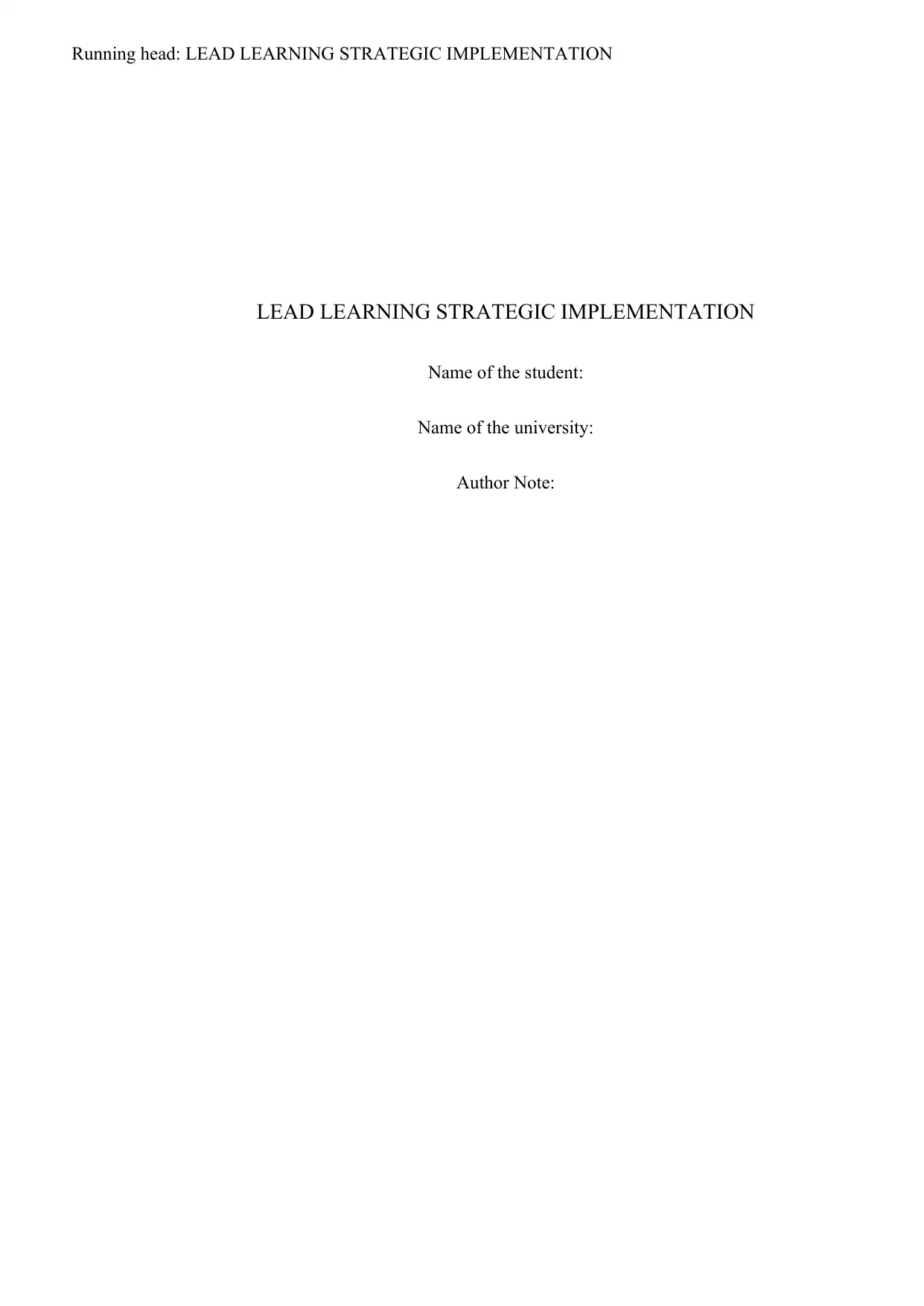
Running head: LEAD LEARNING STRATEGIC IMPLEMENTATION
LEAD LEARNING STRATEGIC IMPLEMENTATION
Name of the student:
Name of the university:
Author Note:
LEAD LEARNING STRATEGIC IMPLEMENTATION
Name of the student:
Name of the university:
Author Note:
Paraphrase This Document
Need a fresh take? Get an instant paraphrase of this document with our AI Paraphraser
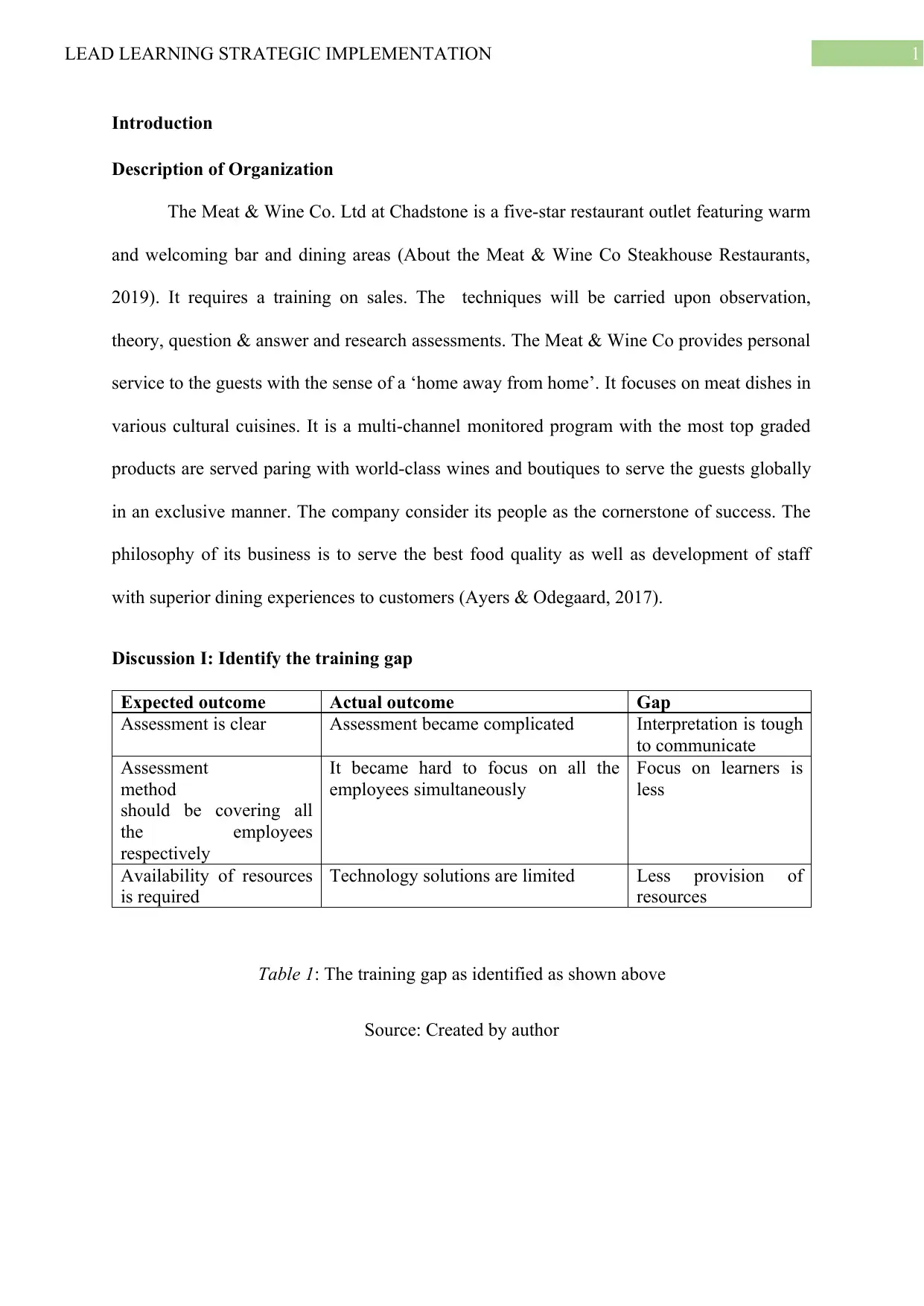
1LEAD LEARNING STRATEGIC IMPLEMENTATION
Introduction
Description of Organization
The Meat & Wine Co. Ltd at Chadstone is a five-star restaurant outlet featuring warm
and welcoming bar and dining areas (About the Meat & Wine Co Steakhouse Restaurants,
2019). It requires a training on sales. The techniques will be carried upon observation,
theory, question & answer and research assessments. The Meat & Wine Co provides personal
service to the guests with the sense of a ‘home away from home’. It focuses on meat dishes in
various cultural cuisines. It is a multi-channel monitored program with the most top graded
products are served paring with world-class wines and boutiques to serve the guests globally
in an exclusive manner. The company consider its people as the cornerstone of success. The
philosophy of its business is to serve the best food quality as well as development of staff
with superior dining experiences to customers (Ayers & Odegaard, 2017).
Discussion I: Identify the training gap
Expected outcome Actual outcome Gap
Assessment is clear Assessment became complicated Interpretation is tough
to communicate
Assessment
method
should be covering all
the employees
respectively
It became hard to focus on all the
employees simultaneously
Focus on learners is
less
Availability of resources
is required
Technology solutions are limited Less provision of
resources
Table 1: The training gap as identified as shown above
Source: Created by author
Introduction
Description of Organization
The Meat & Wine Co. Ltd at Chadstone is a five-star restaurant outlet featuring warm
and welcoming bar and dining areas (About the Meat & Wine Co Steakhouse Restaurants,
2019). It requires a training on sales. The techniques will be carried upon observation,
theory, question & answer and research assessments. The Meat & Wine Co provides personal
service to the guests with the sense of a ‘home away from home’. It focuses on meat dishes in
various cultural cuisines. It is a multi-channel monitored program with the most top graded
products are served paring with world-class wines and boutiques to serve the guests globally
in an exclusive manner. The company consider its people as the cornerstone of success. The
philosophy of its business is to serve the best food quality as well as development of staff
with superior dining experiences to customers (Ayers & Odegaard, 2017).
Discussion I: Identify the training gap
Expected outcome Actual outcome Gap
Assessment is clear Assessment became complicated Interpretation is tough
to communicate
Assessment
method
should be covering all
the employees
respectively
It became hard to focus on all the
employees simultaneously
Focus on learners is
less
Availability of resources
is required
Technology solutions are limited Less provision of
resources
Table 1: The training gap as identified as shown above
Source: Created by author
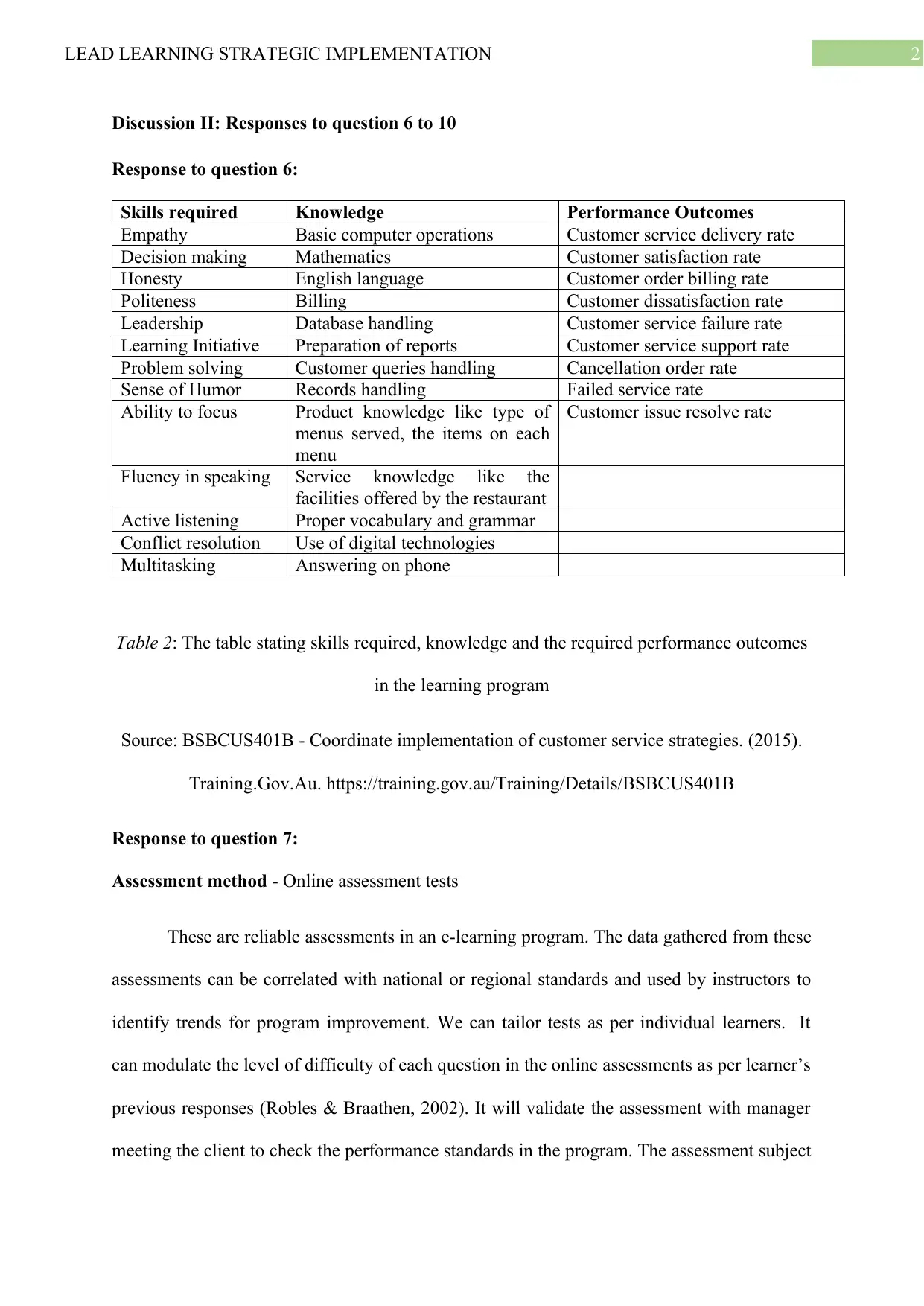
2LEAD LEARNING STRATEGIC IMPLEMENTATION
Discussion II: Responses to question 6 to 10
Response to question 6:
Skills required Knowledge Performance Outcomes
Empathy Basic computer operations Customer service delivery rate
Decision making Mathematics Customer satisfaction rate
Honesty English language Customer order billing rate
Politeness Billing Customer dissatisfaction rate
Leadership Database handling Customer service failure rate
Learning Initiative Preparation of reports Customer service support rate
Problem solving Customer queries handling Cancellation order rate
Sense of Humor Records handling Failed service rate
Ability to focus Product knowledge like type of
menus served, the items on each
menu
Customer issue resolve rate
Fluency in speaking Service knowledge like the
facilities offered by the restaurant
Active listening Proper vocabulary and grammar
Conflict resolution Use of digital technologies
Multitasking Answering on phone
Table 2: The table stating skills required, knowledge and the required performance outcomes
in the learning program
Source: BSBCUS401B - Coordinate implementation of customer service strategies. (2015).
Training.Gov.Au. https://training.gov.au/Training/Details/BSBCUS401B
Response to question 7:
Assessment method - Online assessment tests
These are reliable assessments in an e-learning program. The data gathered from these
assessments can be correlated with national or regional standards and used by instructors to
identify trends for program improvement. We can tailor tests as per individual learners. It
can modulate the level of difficulty of each question in the online assessments as per learner’s
previous responses (Robles & Braathen, 2002). It will validate the assessment with manager
meeting the client to check the performance standards in the program. The assessment subject
Discussion II: Responses to question 6 to 10
Response to question 6:
Skills required Knowledge Performance Outcomes
Empathy Basic computer operations Customer service delivery rate
Decision making Mathematics Customer satisfaction rate
Honesty English language Customer order billing rate
Politeness Billing Customer dissatisfaction rate
Leadership Database handling Customer service failure rate
Learning Initiative Preparation of reports Customer service support rate
Problem solving Customer queries handling Cancellation order rate
Sense of Humor Records handling Failed service rate
Ability to focus Product knowledge like type of
menus served, the items on each
menu
Customer issue resolve rate
Fluency in speaking Service knowledge like the
facilities offered by the restaurant
Active listening Proper vocabulary and grammar
Conflict resolution Use of digital technologies
Multitasking Answering on phone
Table 2: The table stating skills required, knowledge and the required performance outcomes
in the learning program
Source: BSBCUS401B - Coordinate implementation of customer service strategies. (2015).
Training.Gov.Au. https://training.gov.au/Training/Details/BSBCUS401B
Response to question 7:
Assessment method - Online assessment tests
These are reliable assessments in an e-learning program. The data gathered from these
assessments can be correlated with national or regional standards and used by instructors to
identify trends for program improvement. We can tailor tests as per individual learners. It
can modulate the level of difficulty of each question in the online assessments as per learner’s
previous responses (Robles & Braathen, 2002). It will validate the assessment with manager
meeting the client to check the performance standards in the program. The assessment subject
⊘ This is a preview!⊘
Do you want full access?
Subscribe today to unlock all pages.

Trusted by 1+ million students worldwide
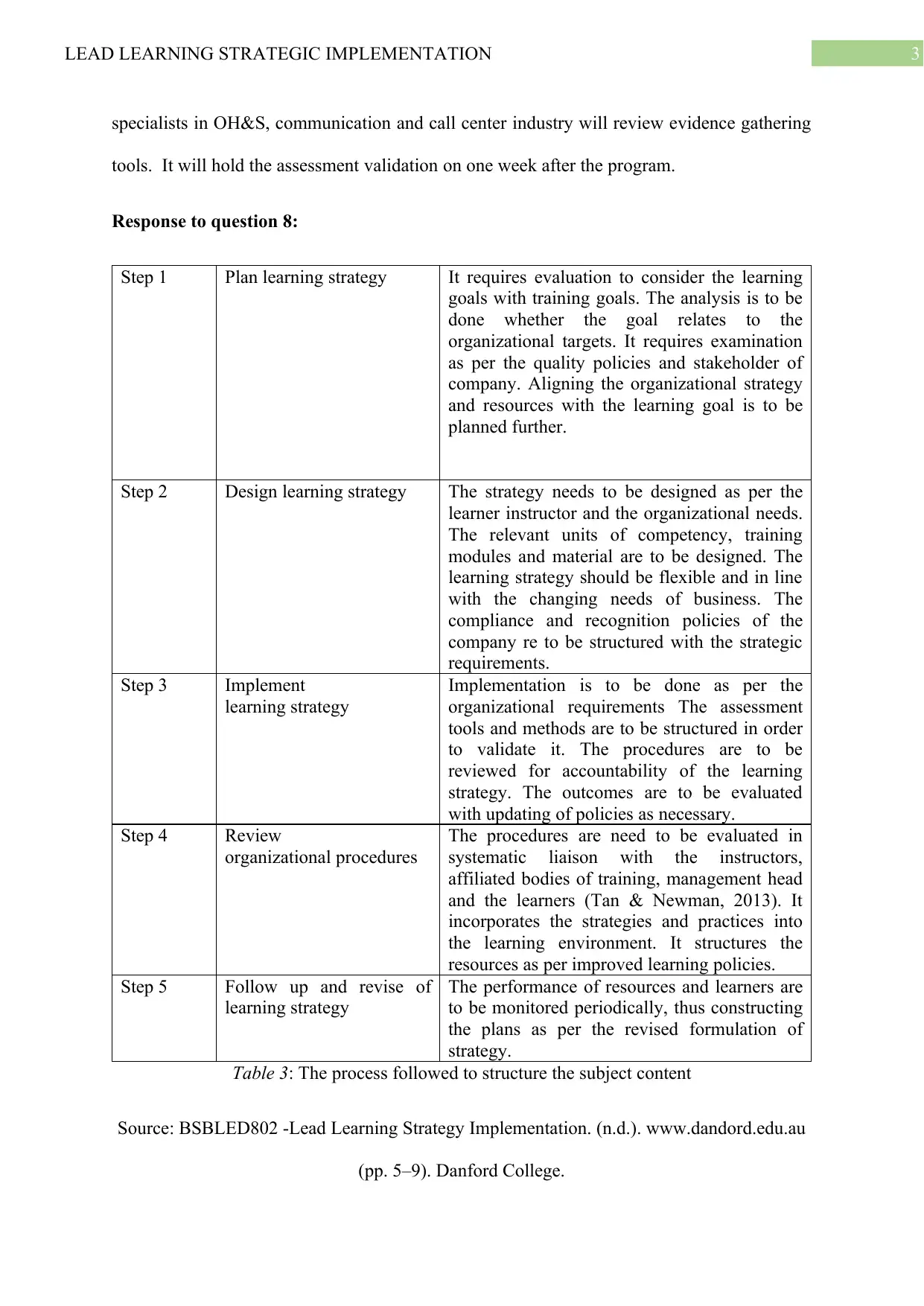
3LEAD LEARNING STRATEGIC IMPLEMENTATION
specialists in OH&S, communication and call center industry will review evidence gathering
tools. It will hold the assessment validation on one week after the program.
Response to question 8:
Step 1 Plan learning strategy It requires evaluation to consider the learning
goals with training goals. The analysis is to be
done whether the goal relates to the
organizational targets. It requires examination
as per the quality policies and stakeholder of
company. Aligning the organizational strategy
and resources with the learning goal is to be
planned further.
Step 2 Design learning strategy The strategy needs to be designed as per the
learner instructor and the organizational needs.
The relevant units of competency, training
modules and material are to be designed. The
learning strategy should be flexible and in line
with the changing needs of business. The
compliance and recognition policies of the
company re to be structured with the strategic
requirements.
Step 3 Implement
learning strategy
Implementation is to be done as per the
organizational requirements The assessment
tools and methods are to be structured in order
to validate it. The procedures are to be
reviewed for accountability of the learning
strategy. The outcomes are to be evaluated
with updating of policies as necessary.
Step 4 Review
organizational procedures
The procedures are need to be evaluated in
systematic liaison with the instructors,
affiliated bodies of training, management head
and the learners (Tan & Newman, 2013). It
incorporates the strategies and practices into
the learning environment. It structures the
resources as per improved learning policies.
Step 5 Follow up and revise of
learning strategy
The performance of resources and learners are
to be monitored periodically, thus constructing
the plans as per the revised formulation of
strategy.
Table 3: The process followed to structure the subject content
Source: BSBLED802 -Lead Learning Strategy Implementation. (n.d.). www.dandord.edu.au
(pp. 5–9). Danford College.
specialists in OH&S, communication and call center industry will review evidence gathering
tools. It will hold the assessment validation on one week after the program.
Response to question 8:
Step 1 Plan learning strategy It requires evaluation to consider the learning
goals with training goals. The analysis is to be
done whether the goal relates to the
organizational targets. It requires examination
as per the quality policies and stakeholder of
company. Aligning the organizational strategy
and resources with the learning goal is to be
planned further.
Step 2 Design learning strategy The strategy needs to be designed as per the
learner instructor and the organizational needs.
The relevant units of competency, training
modules and material are to be designed. The
learning strategy should be flexible and in line
with the changing needs of business. The
compliance and recognition policies of the
company re to be structured with the strategic
requirements.
Step 3 Implement
learning strategy
Implementation is to be done as per the
organizational requirements The assessment
tools and methods are to be structured in order
to validate it. The procedures are to be
reviewed for accountability of the learning
strategy. The outcomes are to be evaluated
with updating of policies as necessary.
Step 4 Review
organizational procedures
The procedures are need to be evaluated in
systematic liaison with the instructors,
affiliated bodies of training, management head
and the learners (Tan & Newman, 2013). It
incorporates the strategies and practices into
the learning environment. It structures the
resources as per improved learning policies.
Step 5 Follow up and revise of
learning strategy
The performance of resources and learners are
to be monitored periodically, thus constructing
the plans as per the revised formulation of
strategy.
Table 3: The process followed to structure the subject content
Source: BSBLED802 -Lead Learning Strategy Implementation. (n.d.). www.dandord.edu.au
(pp. 5–9). Danford College.
Paraphrase This Document
Need a fresh take? Get an instant paraphrase of this document with our AI Paraphraser
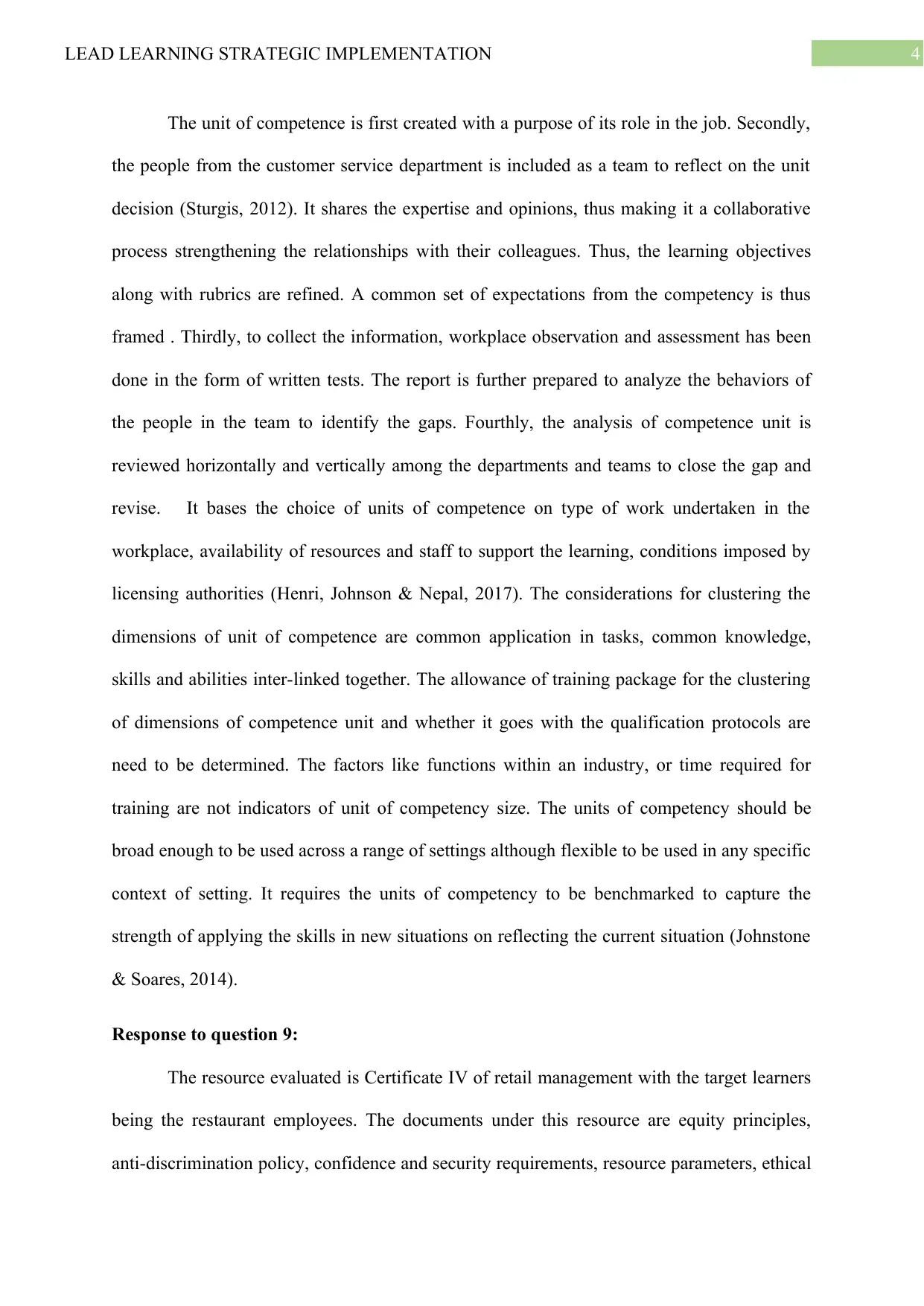
4LEAD LEARNING STRATEGIC IMPLEMENTATION
The unit of competence is first created with a purpose of its role in the job. Secondly,
the people from the customer service department is included as a team to reflect on the unit
decision (Sturgis, 2012). It shares the expertise and opinions, thus making it a collaborative
process strengthening the relationships with their colleagues. Thus, the learning objectives
along with rubrics are refined. A common set of expectations from the competency is thus
framed . Thirdly, to collect the information, workplace observation and assessment has been
done in the form of written tests. The report is further prepared to analyze the behaviors of
the people in the team to identify the gaps. Fourthly, the analysis of competence unit is
reviewed horizontally and vertically among the departments and teams to close the gap and
revise. It bases the choice of units of competence on type of work undertaken in the
workplace, availability of resources and staff to support the learning, conditions imposed by
licensing authorities (Henri, Johnson & Nepal, 2017). The considerations for clustering the
dimensions of unit of competence are common application in tasks, common knowledge,
skills and abilities inter-linked together. The allowance of training package for the clustering
of dimensions of competence unit and whether it goes with the qualification protocols are
need to be determined. The factors like functions within an industry, or time required for
training are not indicators of unit of competency size. The units of competency should be
broad enough to be used across a range of settings although flexible to be used in any specific
context of setting. It requires the units of competency to be benchmarked to capture the
strength of applying the skills in new situations on reflecting the current situation (Johnstone
& Soares, 2014).
Response to question 9:
The resource evaluated is Certificate IV of retail management with the target learners
being the restaurant employees. The documents under this resource are equity principles,
anti-discrimination policy, confidence and security requirements, resource parameters, ethical
The unit of competence is first created with a purpose of its role in the job. Secondly,
the people from the customer service department is included as a team to reflect on the unit
decision (Sturgis, 2012). It shares the expertise and opinions, thus making it a collaborative
process strengthening the relationships with their colleagues. Thus, the learning objectives
along with rubrics are refined. A common set of expectations from the competency is thus
framed . Thirdly, to collect the information, workplace observation and assessment has been
done in the form of written tests. The report is further prepared to analyze the behaviors of
the people in the team to identify the gaps. Fourthly, the analysis of competence unit is
reviewed horizontally and vertically among the departments and teams to close the gap and
revise. It bases the choice of units of competence on type of work undertaken in the
workplace, availability of resources and staff to support the learning, conditions imposed by
licensing authorities (Henri, Johnson & Nepal, 2017). The considerations for clustering the
dimensions of unit of competence are common application in tasks, common knowledge,
skills and abilities inter-linked together. The allowance of training package for the clustering
of dimensions of competence unit and whether it goes with the qualification protocols are
need to be determined. The factors like functions within an industry, or time required for
training are not indicators of unit of competency size. The units of competency should be
broad enough to be used across a range of settings although flexible to be used in any specific
context of setting. It requires the units of competency to be benchmarked to capture the
strength of applying the skills in new situations on reflecting the current situation (Johnstone
& Soares, 2014).
Response to question 9:
The resource evaluated is Certificate IV of retail management with the target learners
being the restaurant employees. The documents under this resource are equity principles,
anti-discrimination policy, confidence and security requirements, resource parameters, ethical
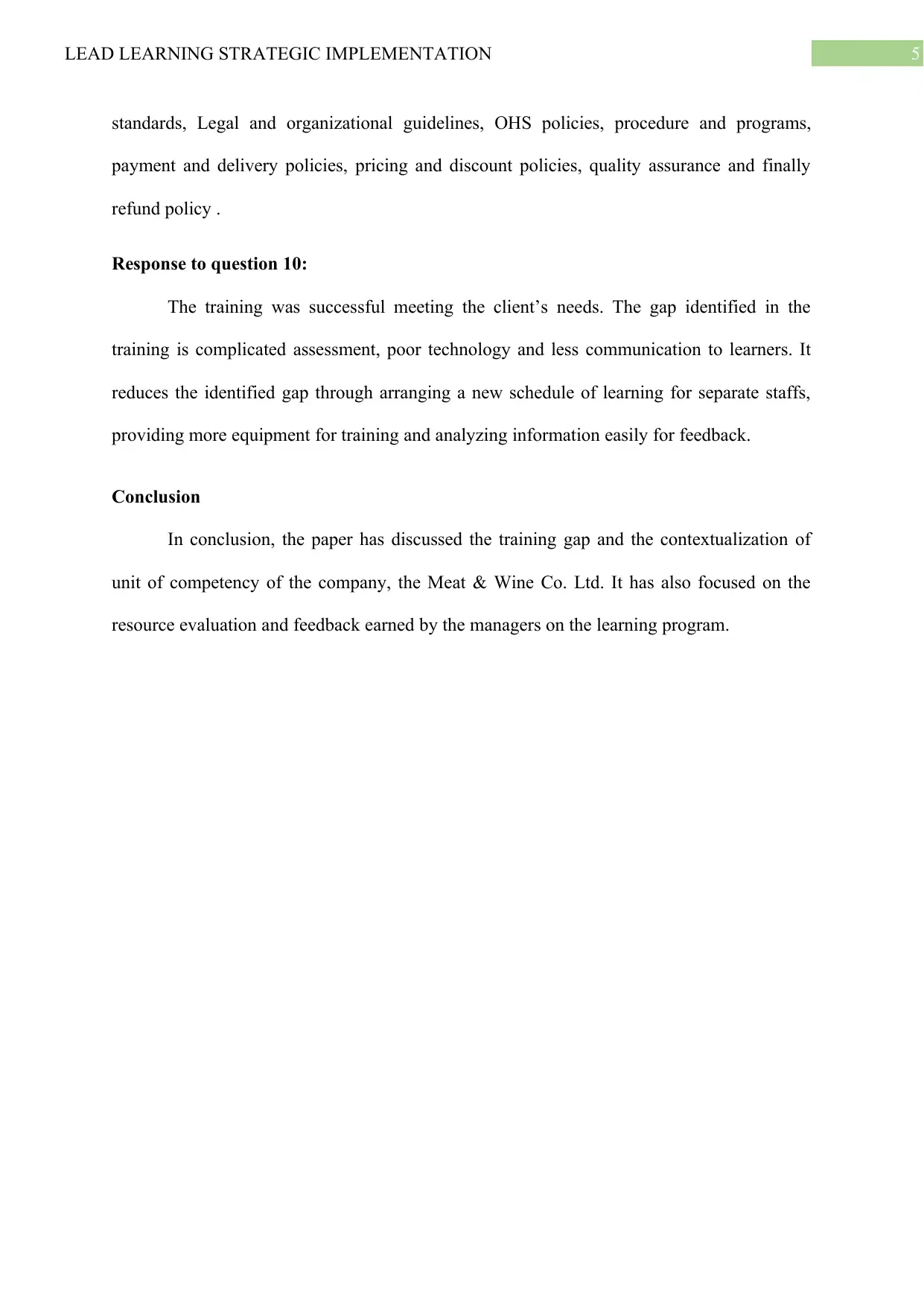
5LEAD LEARNING STRATEGIC IMPLEMENTATION
standards, Legal and organizational guidelines, OHS policies, procedure and programs,
payment and delivery policies, pricing and discount policies, quality assurance and finally
refund policy .
Response to question 10:
The training was successful meeting the client’s needs. The gap identified in the
training is complicated assessment, poor technology and less communication to learners. It
reduces the identified gap through arranging a new schedule of learning for separate staffs,
providing more equipment for training and analyzing information easily for feedback.
Conclusion
In conclusion, the paper has discussed the training gap and the contextualization of
unit of competency of the company, the Meat & Wine Co. Ltd. It has also focused on the
resource evaluation and feedback earned by the managers on the learning program.
standards, Legal and organizational guidelines, OHS policies, procedure and programs,
payment and delivery policies, pricing and discount policies, quality assurance and finally
refund policy .
Response to question 10:
The training was successful meeting the client’s needs. The gap identified in the
training is complicated assessment, poor technology and less communication to learners. It
reduces the identified gap through arranging a new schedule of learning for separate staffs,
providing more equipment for training and analyzing information easily for feedback.
Conclusion
In conclusion, the paper has discussed the training gap and the contextualization of
unit of competency of the company, the Meat & Wine Co. Ltd. It has also focused on the
resource evaluation and feedback earned by the managers on the learning program.
⊘ This is a preview!⊘
Do you want full access?
Subscribe today to unlock all pages.

Trusted by 1+ million students worldwide
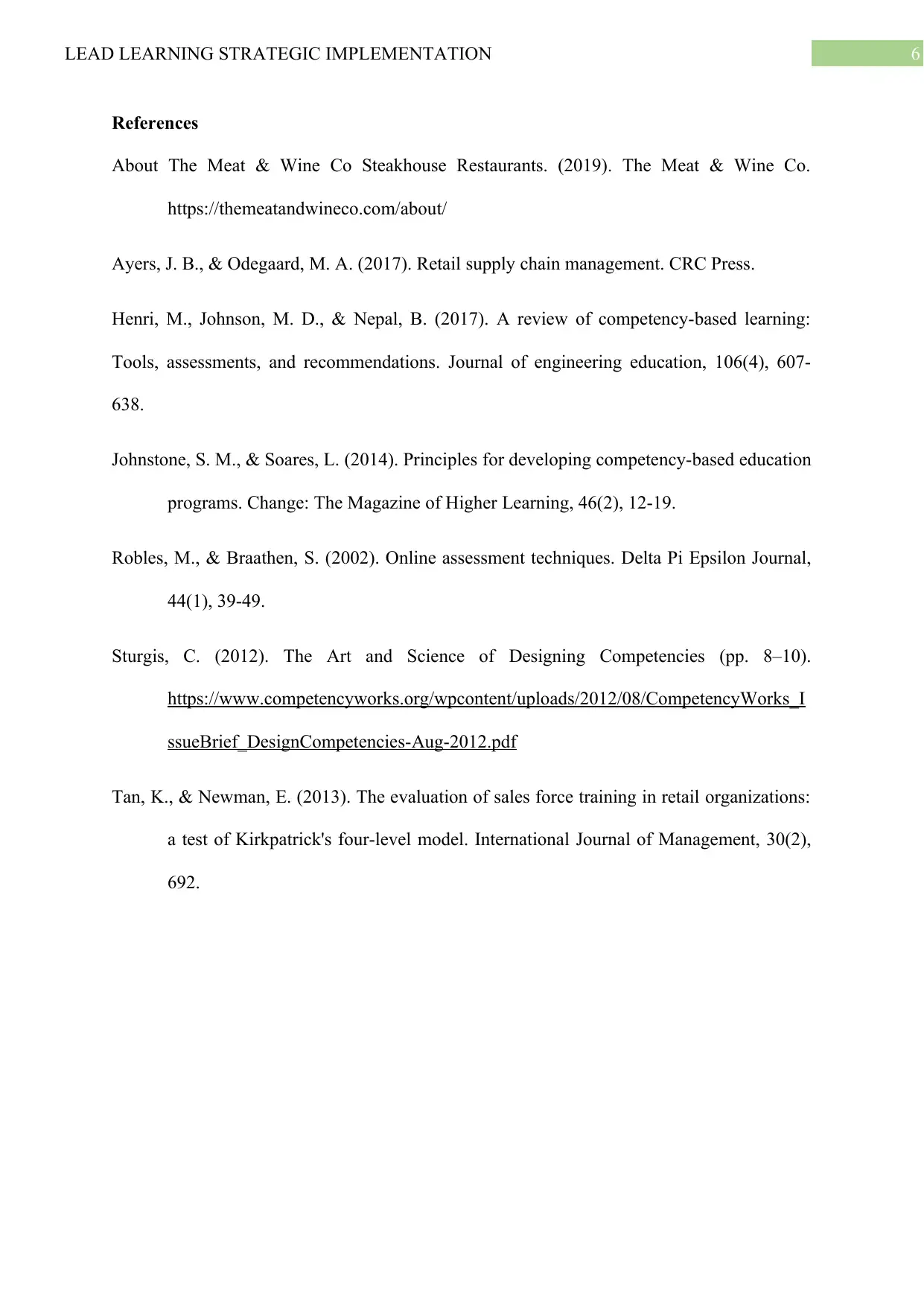
6LEAD LEARNING STRATEGIC IMPLEMENTATION
References
About The Meat & Wine Co Steakhouse Restaurants. (2019). The Meat & Wine Co.
https://themeatandwineco.com/about/
Ayers, J. B., & Odegaard, M. A. (2017). Retail supply chain management. CRC Press.
Henri, M., Johnson, M. D., & Nepal, B. (2017). A review of competency‐based learning:
Tools, assessments, and recommendations. Journal of engineering education, 106(4), 607-
638.
Johnstone, S. M., & Soares, L. (2014). Principles for developing competency-based education
programs. Change: The Magazine of Higher Learning, 46(2), 12-19.
Robles, M., & Braathen, S. (2002). Online assessment techniques. Delta Pi Epsilon Journal,
44(1), 39-49.
Sturgis, C. (2012). The Art and Science of Designing Competencies (pp. 8–10).
https://www.competencyworks.org/wpcontent/uploads/2012/08/CompetencyWorks_I
ssueBrief_DesignCompetencies-Aug-2012.pdf
Tan, K., & Newman, E. (2013). The evaluation of sales force training in retail organizations:
a test of Kirkpatrick's four-level model. International Journal of Management, 30(2),
692.
References
About The Meat & Wine Co Steakhouse Restaurants. (2019). The Meat & Wine Co.
https://themeatandwineco.com/about/
Ayers, J. B., & Odegaard, M. A. (2017). Retail supply chain management. CRC Press.
Henri, M., Johnson, M. D., & Nepal, B. (2017). A review of competency‐based learning:
Tools, assessments, and recommendations. Journal of engineering education, 106(4), 607-
638.
Johnstone, S. M., & Soares, L. (2014). Principles for developing competency-based education
programs. Change: The Magazine of Higher Learning, 46(2), 12-19.
Robles, M., & Braathen, S. (2002). Online assessment techniques. Delta Pi Epsilon Journal,
44(1), 39-49.
Sturgis, C. (2012). The Art and Science of Designing Competencies (pp. 8–10).
https://www.competencyworks.org/wpcontent/uploads/2012/08/CompetencyWorks_I
ssueBrief_DesignCompetencies-Aug-2012.pdf
Tan, K., & Newman, E. (2013). The evaluation of sales force training in retail organizations:
a test of Kirkpatrick's four-level model. International Journal of Management, 30(2),
692.
1 out of 7
Related Documents
Your All-in-One AI-Powered Toolkit for Academic Success.
+13062052269
info@desklib.com
Available 24*7 on WhatsApp / Email
![[object Object]](/_next/static/media/star-bottom.7253800d.svg)
Unlock your academic potential
Copyright © 2020–2025 A2Z Services. All Rights Reserved. Developed and managed by ZUCOL.





